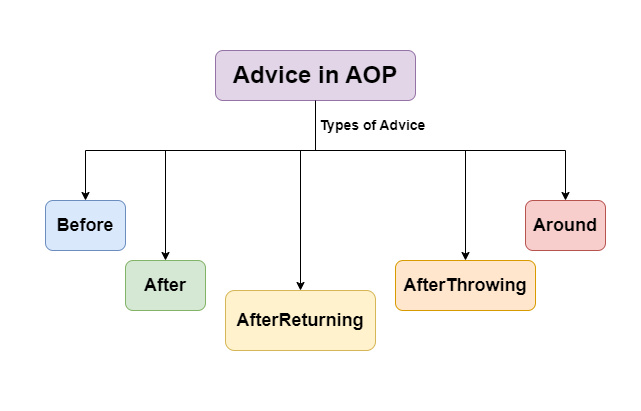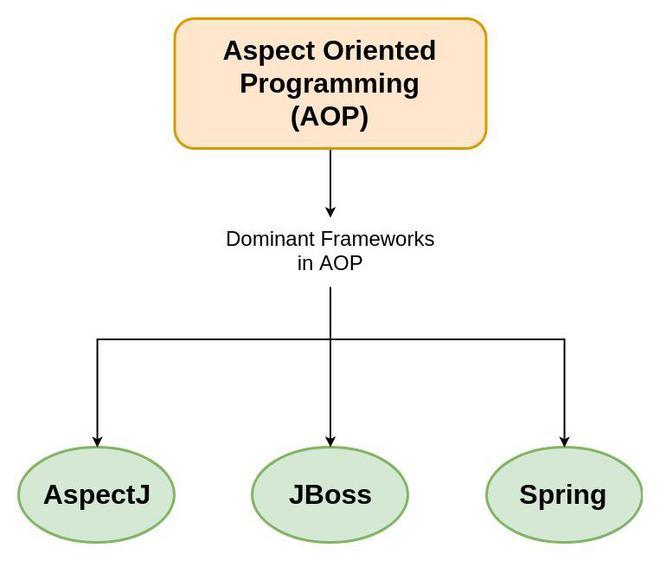Aspect Oriented Programming (AOP) in Spring Framework (original) (raw)
Last Updated : 20 Mar, 2025
**Aspect-Oriented Programming (AOP) in Spring Boot is a powerful feature that enhances modularity by handling cross-cutting concerns such as **logging, security, and **transaction management separately from business logic. Without AOP, these concerns would be scattered throughout the codebase, leading to duplication and maintenance challenges. **Spring AOP provides a lightweight proxy-based approach to implementing AOP efficiently in enterprise applications. In this article, we will explore **AOP concepts, Spring AOP implementation, and real-world examples to help you integrate AOP into your Spring Boot projects effectively.
Understanding AOP Concepts
- **Aspect: An Aspect is a modular unit of cross-cutting concerns. For example, a logging aspect can be applied across various methods in different classes..
- **Advice: This is the action taken by an aspect at a particular join point. There are five types of advice:
- **Before: Executed before the method call.
- **After: Executed after the method call, regardless of its outcome.
- **AfterReturning: Executed after the method returns a result, but not if an exception occurs.
- **Around: Surrounds the method execution, allowing you to control the method execution and its result.
- **AfterThrowing: Executed if the method throws an exception.

- **Join Point: A specific point in the execution of a program, such as method execution or exception handling, where an aspect can be applied.
- **Pointcut: A Pointcut is a predicate that defines where advice should be applied. It matches join points using expressions.
- **Weaving: This is the process of linking aspects with the target object. Spring AOP only supports runtime weaving using proxy-based mechanisms (JDK dynamic proxies for interfaces and CGLIB for concrete classes). It does not modify bytecode like AspectJ.
Dominant AOP Frameworks
- **AspectJ: A powerful and mature AOP framework that supports compile-time and load-time weaving. It offers full AOP support with its own syntax and tools.
- **JBoss AOP: Part of the JBoss application server, offering integration with Java EE applications.
- **Spring AOP: A simpler, proxy-based framework that integrates with the Spring Framework, using XML configurations or annotations to define aspects and pointcuts.

AOP in the Spring Framework
Spring AOP leverages proxy-based mechanisms to provide aspect-oriented functionality. It creates a proxy object that wraps around the original object, adding the necessary advice. This proxy can be generated automatically using configurations in XML or annotations like @Aspect .
Example: Implementing Logging with AOP in Spring
Here's a practical example to illustrate AOP concepts in Spring:
**Aspect Class with Different Types of Advice:
Java `
package com.example.aspect;
import org.aspectj.lang.JoinPoint; import org.aspectj.lang.ProceedingJoinPoint; import org.aspectj.lang.annotation.After; import org.aspectj.lang.annotation.AfterReturning; import org.aspectj.lang.annotation.AfterThrowing; import org.aspectj.lang.annotation.Around; import org.aspectj.lang.annotation.Aspect; import org.aspectj.lang.annotation.Before; import org.aspectj.lang.annotation.Pointcut; import org.springframework.stereotype.Component;
@Aspect // Marks the class as an aspect, which contains cross-cutting concerns @Component // Registers this aspect as a Spring bean public class LoggingAspect {
@Pointcut("execution(public void com.example.service.*.*(..))")
// Defines a pointcut that matches the execution of any public method in classes under com.example.service package
public void allServiceMethods() {}
@Before("allServiceMethods()")
// Advice that runs before the execution of methods matched by the pointcut
public void logBefore(JoinPoint joinPoint) {
System.out.println("Before method: " + joinPoint.getSignature().getName());
}
@After("allServiceMethods()")
// Advice that runs after the execution of methods matched by the pointcut, regardless of their outcome
public void logAfter(JoinPoint joinPoint) {
System.out.println("After method: " + joinPoint.getSignature().getName());
}
@AfterReturning(pointcut = "allServiceMethods()", returning = "result")
// Advice that runs after a method matched by the pointcut returns successfully
public void logAfterReturning(JoinPoint joinPoint, Object result) {
System.out.println("Method returned: " + result);
}
@AfterThrowing(pointcut = "allServiceMethods()", throwing = "error")
// Advice that runs if a method matched by the pointcut throws an exception
public void logAfterThrowing(JoinPoint joinPoint, Throwable error) {
System.out.println("Method threw exception: " + error);
}
@Around("allServiceMethods()")
// Advice that runs before and after the execution of methods matched by the pointcut
public Object logAround(ProceedingJoinPoint joinPoint) throws Throwable {
System.out.println("Before and after method: " + joinPoint.getSignature().getName());
return joinPoint.proceed(); // Proceed with the next advice or target method invocation
}}
`
**Key Concepts:
- **Aspect: The LoggingAspect class is an aspect handling logging functionality.
- **Pointcut: Defined using @Pointcut, it determines where advice should be applied.
- **Advice: Different types of advice execute at various points during method execution.
Enabling AOP in Spring
Java-Based Configuration
To enable AOP in Spring, you need to configure your Spring application context appropriately.
Java `
import org.springframework.context.annotation.Configuration; import org.springframework.context.annotation.EnableAspectJAutoProxy;
@Configuration @EnableAspectJAutoProxy public class AopConfig { }
`
XML Configuration
XML `
<aop:aspectj-autoproxy/>
<bean id="loggingAspect" class="com.example.aspect.LoggingAspect"/>`
This article provides a comprehensive overview of AOP concepts and their implementation in the Spring Framework, with practical examples to illustrate the concepts in action.